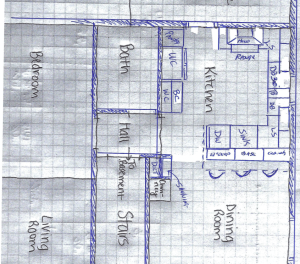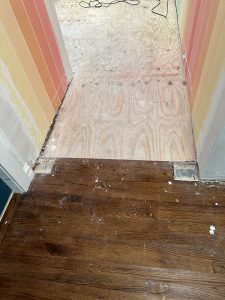
“Jenna” had a problem. She had been to more than 10 doctors, yet nobody could identify the cause of the cracked, peeling skin on her legs. They were incredibly painful, especially at night, and made her skin look as if it were made of fish scales instead of human flesh.
Finally, a doctor diagnosed ichthyosis, a rare skin disorder that makes skin so dry and scaly it literally appears to belong to another species. In fact, the word comes from the ancient Greek root ichthys, which means, not surprisingly, fish. While the severity of ichthyosis can vary from individual to individual, Jenna’s case was obviously quite severe.
“It was often just plain agony,” says Jenna, 28. “My legs hurt really badly and when I used to wrap them up in bandages at night the bandages would stick to my legs, making it excruciatingly painful to peel off.
“Whenever I would go clubbing I’d pray the lights would stay off, as I was too embarrassed for anyone to see my legs. They looked absolutely hideous, and I would keep them completely hidden during the day just because I felt so ashamed.”
Finally, a doctor diagnosed ichthyosis, a rare skin disorder that makes skin so dry and scaly it literally appears to belong to another species. In fact, the word comes from the ancient Greek root ichthys, which means, not surprisingly, fish. While the severity of ichthyosis can vary from individual to individual, Jenna’s case was obviously quite severe.
What is Ichthyosis?
In people with normal skin, the outer layer, or the epidermis, contains cells that are constantly dividing and then being shed. People with ichthyosis, however, either have skin cells which reproduce at an alarming rate that is a lot quicker than they can be shed, or scales that don’t shed at all, therefore causing a build-up of skin.
The result of this usually genetic skin condition is that the cells pile up on top of one another, creating a thick, scaly appearance. Sometimes, in severe cases such as Jenna’s, the skin becomes almost unbearably dry and cracks, and can even restrict movement. Usually the legs are affected, although sometimes the hands and arms are as well.
The problem is because this ailment is relatively rare, many doctors and even some dermatologists may not recognize it for what it is, therefore giving the wrong treatment – or prescribing no treatment at all.
There are several main types of ichthyosis, including:
* Hereditary Ichthyosis Vulgaris. The most common type, affecting about 95 percent of people with ichthyosis. Skin may appear normal when a child is born but symptoms usually appear by age five at the latest. All parts of the body can be affected, and is often associated with atopic dermatitis. It is estimated that at least one person in every 300 in the United States has this condition to some degree, and race and sex are unimportant. A child of a parent with the disorder has a one in two chance of having it as well.
* Acquired Ichthyosis. As the name suggest, this type of the disorder is acquired and usually appears in adulthood. It is very rare and is often attributed to taking certain medications or because the sufferer has an underlying medical or other condition, such as HIV/AIDS, leprosy, certain types of cancer or glandular problems. Severely poor nutrition may also play a role in whether an individual acquires ichthyosis.
* Harlequin Ichthyosis. A congenital condition where an infant is born with thick skin all over his or her body, which eventually cracks and causes deep, painful fissures. Incredibly rare, the chances of having it are only one in a million as both parents must be carriers. Most children born with this condition die soon after they are born due to loss of fluid, if they survive the life expectancy is not very high.
Symptoms and Signs
It can be difficult for doctors to diagnose ichthyosis, although it is relatively common, as mild forms are easy to confuse with other skin conditions. However, as conditions such as eczema are often treated with steroids, to which ichthyosis does not respond (see below), it is important to get the correct diagnosis.
Here are some signs to watch out for if you suspect you or your children have ichthyosis vulgaris, the most common kind:
* Scaling on the front of the legs
* Scaling on the back of the arm
* Scaling on the back or scalp
* Scaling on cheeks and forehead, which is more prominent in children of a younger age
Keep in mind that there are also certain areas of the body which are not affected by the condition, so if you have itchy, scaly skin in those places there is an excellent chance it is something else. These areas are: the tummy, face, front of neck, and folds in front of knees and elbows (which usually are prime places for eczema).
Treatment Options
While ichthyosis vulgaris may improve with age, often constant therapy is required to keep the scaling under control and make the patient feel more comfortable in his or her own skin. Usually a two-pronged approach is taken, one an emollient or moisturizer to hydrate the skin, the other an ointment to prevent the moisture from evaporating and making the skin dry up even more.
Usually alpha-hydroxy acids are used to hydrate, while other solutions are put into place to take off the hardened scales and reveal softer skin. Salicylic acid is commonly used, what you would employ would depend on the advice of your doctor. Steroids do not usually help although topical retinoids can be useful.
In Jenna’s case, she was advised to apply both a moisturizer and ointment several times a day, and to wrap her legs in cellophane every evening once they were sufficiently creamed. Within a few months her condition improved to the point where the scales were no longer visible at all. “I literally have been given back my life,” she says.
The information in the article is not intended to substitute for the medical expertise and advice of your health care provider. We encourage you to discuss any decisions about treatment or care an appropriate health care provider.
Source by S Matthews






